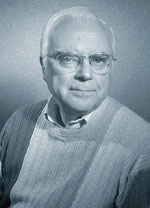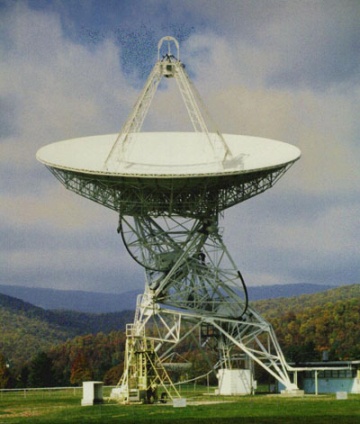|
|
| (未显示3个用户的25个中间版本) |
| 第1行: |
第1行: |
| − | <资料来源:[http://www.planetary.org/explore/topics/seti/seti_history_04.html The Planetary Society]> | + | <资料来源:[https://archive.md/2008.12.08-203939/http://www.planetary.org/explore/topics/seti/seti_history_04.html The Origins of Project Ozma]> |
| | | | |
| | | | |
| − | =='''第4章:Ozma项目的起源'''== | + | =='''第4章:Ozma 项目的起源'''== |
| | | | |
| − | At around the same time that Morrison and Cocconi were speculating about alien signals, a young astronomer named Frank Drake was pursuing his own investigations into interstellar communications. Drake was a staff member at the National Radio Astronomy Observatory at Green Bank, West Virginia. At the time, the newly established NRAO was in the odd position of being a radio observatory without a radio telescope. The 140-foot dish panned for the site was in the early stages of what turned out to be a very troublesome construction. It would not be completed until years later. As a stopgap measure, the NRAO purchased an 85-foot radio telescope, which became operational in April of 1959.
| + | 正当 Morrison 和 Cocconi 揣摩着外星信号的同时,一位年轻的天文学家 Frank Drake 也在进行他自己的星际通讯研究。Drake 是西佛吉尼亚州 Green Bank 国家射电天文台(NRAO)的一名工作人员,当时,新成立的 NRAO 位于偏远的地区并没有射电望远镜。建造直径 140 英尺(42.672米)的碟状天线在当时来说是非常棘手的,它在许多年以后才被建成。当时作为权宜之计,NRAO 购买了一个直径 85 英尺(25.908 米)的射电望远镜,并于 1959 年 4 月开始运作。 |
| | | | |
| − | 正当 Morrison 和 Cocconi 揣摩着外来信号的同时,一位年轻的天文学家 Frank Drake 继续进行自己的星际通讯研究。Drake 是西佛吉尼亚州绿岸国家射电天文台(NRAO)的一名工作人员,当时,新成立射电天文台的 NRAO 位于偏移的地区并没有射电望远镜。建造直径140英尺(42.672米)的单碟计划在早期来说是非常棘手的,它在许多年以后才被建成。当时作为权宜之计,NRAO购买了一个直径85英尺(25.908米)射电望远镜,并与1959年4月开始运作。
| |
| | | | |
| | + | [[Image:Drake.jpg|left|thumb|150px|'''Frank Drake 博士,摄于 20 世纪 90 年代'''<br> |
| | + | 图片提供:[[SETI 研究所]]]] |
| | + | 作为 Green Bank 的一名初级工作人员,Drake 在 NRAO 参与了许多射电天文学项目。然而他对寻找外星文明非常入迷,毕业于康奈尔大学射电天文专业的 Drake 曾在昴宿星方向检测到一个强烈的疑似人工无线电信号。Drake 经过数周的分析得出结论是源于地球上的信号,但对于可能检测到地外文明的无线电信号的想法一直环绕在他脑海中。 |
| | | | |
| − | [[Image:Drake.jpg|left|thumb|150px|'''Dr. Frank Drake in the 1990's'''<br>
| |
| − | Credit: The SETI Institute]]
| |
| | | | |
| − | As a junior staff member in Green Bank, Drake had a part in many of the radio-astronomy projects at NRAO. His fascination, however, was with the search for alien civilizations. As a graduate student in radio astronomy at Cornell, Drake had once detected a strong seemingly artificial radio signal coming from the direction of the Pleiades. After weeks of analysis, Drake had concluded that the signal in fact originated on Earth, but the possibility of detecting an alien radio signal remained very much on his mind.
| + | 1959 年 3 月,Drake 计算出如果利用现有的技术从地球发送出一个强大的无线电波信号,它可以被一个直径 85 英尺的射电望远镜在 10 光年距离检测到。换言之,Green Bank 的新射电望远镜有可能探测到 10 光年范围的信号,即使他们的发射器只和现在地球上的一般强大。 Drake 指出在 10 光年范围内有几个类似太阳的恒星。由于这些理由,他认为开始搜寻地外文明是合适的。 |
| | | | |
| | | | |
| − | In March of 1959 Drake calculated that if a strong radio signal would be sent from Earth, using existing technology, it could be detected at a distance of 10 light years by an 85-foot dish. In other words, the new radio telescope at Green Bank should be capable of detecting signals as far as 10 light years away, even if they are sent by transmitters no more powerful than the ones then available on Earth. Drake noted that there were several sun-like stars within a distance of 10 light years from Earth. These, he reasoned, were good candidates for beginning the search for alien intelligence.
| + | 某一天,Drake 与他的同事在天文台不远处午餐并提出了自己的想法:能否使用 Green Bank 新建的射电望远镜进行外星文明搜寻?毫无疑问,Drake 运气很好,和 Jodrell Bank 射电天文台拒绝 Morrison 和 Cocconi 的情况不同,Green Bank 尚未投入使用,因此可以灵活的安排自己的未来计划。更幸运的是,NRAO 的代理主管 Lloyd Berckner 也出席了当天的午餐,同意了 Drake 的建议并安排上了日程。Drake 给这计划命名为“Ozma 项目”,典故来自李曼·法兰克·鲍姆(Frank L. Baum)的经典童话故事『绿野仙踪』中奥兹国的奥兹玛公主(Princess Ozma)。 |
| | | | |
| | | | |
| − | One day, during lunch at a greasy spoon diner not far from the observatory, Drake broached the topics with his colleagues. Would it be possible to use the new radio telescope then being built at Green Bank to search for extraterrestrials? It was, undoubtedly, Drake's good fortune that unlike the Jodrell Bank radio observatory, which had rejected Morison and Cocconi, the Green Bank dish was not yet operational and therefore could be flexible about its future schedule. He was also fortunate that Lloyd Berckner, acting director of NRAO, was present at the lunch that day, and gave Drake's proposal the go-ahead. Drake dubbed the venture "Project Ozma," after Princess Ozma of Oz, from Frank L. Baum's classic tale.
| + | [[Image:Ozma_telescope.jpg|right|thumb|360px|'''Ozma 项目所用的射电望远镜'''<br> |
| | + | Green Bank 的直径 85 英尺射电望远镜,近期拍摄。图片提供:NRAO/AUI]] |
| | | | |
| | + | 接下来的数个月 Green Bank 很繁忙,但即便新的射电望远镜安装完成并开始收集数据后,Drake 和他的同事们仍继续为 Ozma 项目工作。为了节省费用,他们决定把注意力集中在氢元素 1420Mhz 频段,这是射电望远镜的常用工作频率,这么一来就只需要最低限度的变更现有设备。最后,专用于 Ozma 项目的花费没有超过 2000 美元。 |
| | | | |
| − | The months that followed were a busy time in Green Bank. But even while the new radio telescope went on-line and began collecting data, Drake and his colleagues kept up work on Project Ozma. For cost-saving reasons, they decided to concentrate on the hydrogen 1420 MHz band. That was the frequency at which radio telescopes most commonly operate, and it would therefore require the least alterations in the existing equipment. In the end, the price tag for parts unique to Ozma amounted to no more than $2000.
| |
| | | | |
| | + | 在 1959 年年尾有两个事件加速了 Ozma 项目的开展。其中之一是任命 Otto Struve 为 NRAO 的第一任主管。Struve 在测量恒星自转的工作上非常有名,他认为在遥远的恒星轨道上会出现行星。在 Struve 的想法中,这只是从太阳系外行星到地外文明的一个小跨越:他全力支持 Ozma 项目。此外,他还带来了他广泛的关系网和他公众关系的才能。Drake 和他的同事们出于学术体面和精神安宁方面的考虑而选择把它作为一个秘密的项目,Struve 马上在麻省理工学院的一次演讲中把它公诸于众。“秘密被泄露了”数年后 Drake 回顾到。“现在回头看,让它泄露出来是最好不过了”。虽然随后的确有可怕的宣传浪潮,但如此一来得到了公众支持和宝贵的资金和设备捐赠。 |
| | | | |
| − | [[Image:Ozma_telescope.jpg|right|thumb|400px|'''The Project Ozma Radio Telescope'''<br>
| |
| − | The 85 foot radio telescope at Green Bank used by Project Ozma as it appears today. Credit: NRAO/AUI]]
| |
| | | | |
| − | Two events combined to speed up project Ozma in late 1959. One was the appointment of Otto Struve as the first permanent director of NRAO. Struve was famous for his work on the measurement of stellar rotation, which he argued could indicate the presence of planets orbiting distant stars. In Struve's mind, it was only a short leap from extrasolar planets to extraterrestrial intelligence: he supported Ozma wholeheartedly. Furthermore, he brought to the effort his extensive connections and his flair for public relations. Whereas Drake and his colleagues, fearing for their academic respectability and their peace of mind chose to keep the project a secret, Struve went public immediately in a lecture at MIT. "The cat was out of the bag," Drake recalled years later. "Looking back now, only good came from letting it out." While the dreaded wave of publicity did indeed follow, so did public support and valuable donations in money and equipment.
| + | 另外一个事件就是 1959 年 9 月出版于自然杂志中的 Morrison 和 Cocconi 的文章。Drake 对于这些突出的研究人员做着与自己类似的工作感到非常欣慰。特别是 Morrison 和 Cocconi 在相同的搜索频率上提供了理论支持,而 Drake 选择 1420Mhz 这个频率是出于费用的节省。然而 Struve 关心的则是 Ozma 项目团队被剥夺了应有的荣誉,他敦促 Drake 尽快开始搜索行动。 |
| | | | |
| | | | |
| − | The other event was the publication of Morrison and Cocconi's article in Nature in September of 1959. Drake was pleased that such prominent researchers were working along similar lines to his own. In particular, Morrison and Cocconi provided theoretical support for searching at the very same frequency that Drake chose for cost-saving reasons - 1420 MHz. Struve, however, was concerned that the Ozma team would be robbed of their due credit, and he urged Drake to begin the search as soon as possible.
| + | [[SETI 的历史|'''返回 SETI 的历史 ←''']] | [[SETI 的历史 - 3|'''第3章:SETI 的蓝图 ←''']] | [[SETI 的历史 - 5|'''→ 第5章:Ozma 项目 - 搜索''']] |
| − | | |
| − | | |
| − | [[SETI的历史:3 - SETI的蓝图|'''第3章:SETI的蓝图 ←''']] | [[SETI的历史:5 - Ozma项目 - 搜索|'''→ 第5章:Ozma项目 - 搜索''']] | |
| − | | |
| − | ==相关链接==
| |
| − | *[[SETI]]
| |
| − | *[[SETI@home]]
| |
| − | *[[SETI的历史]]
| |
| − | | |
| − | [[Category:SETI 相关文献]][[Category:文献翻译]][[Category:待翻译]]
| |
<资料来源:The Origins of Project Ozma>
第4章:Ozma 项目的起源
正当 Morrison 和 Cocconi 揣摩着外星信号的同时,一位年轻的天文学家 Frank Drake 也在进行他自己的星际通讯研究。Drake 是西佛吉尼亚州 Green Bank 国家射电天文台(NRAO)的一名工作人员,当时,新成立的 NRAO 位于偏远的地区并没有射电望远镜。建造直径 140 英尺(42.672米)的碟状天线在当时来说是非常棘手的,它在许多年以后才被建成。当时作为权宜之计,NRAO 购买了一个直径 85 英尺(25.908 米)的射电望远镜,并于 1959 年 4 月开始运作。

Frank Drake 博士,摄于 20 世纪 90 年代 图片提供:
SETI 研究所 作为 Green Bank 的一名初级工作人员,Drake 在 NRAO 参与了许多射电天文学项目。然而他对寻找外星文明非常入迷,毕业于康奈尔大学射电天文专业的 Drake 曾在昴宿星方向检测到一个强烈的疑似人工无线电信号。Drake 经过数周的分析得出结论是源于地球上的信号,但对于可能检测到地外文明的无线电信号的想法一直环绕在他脑海中。
1959 年 3 月,Drake 计算出如果利用现有的技术从地球发送出一个强大的无线电波信号,它可以被一个直径 85 英尺的射电望远镜在 10 光年距离检测到。换言之,Green Bank 的新射电望远镜有可能探测到 10 光年范围的信号,即使他们的发射器只和现在地球上的一般强大。 Drake 指出在 10 光年范围内有几个类似太阳的恒星。由于这些理由,他认为开始搜寻地外文明是合适的。
某一天,Drake 与他的同事在天文台不远处午餐并提出了自己的想法:能否使用 Green Bank 新建的射电望远镜进行外星文明搜寻?毫无疑问,Drake 运气很好,和 Jodrell Bank 射电天文台拒绝 Morrison 和 Cocconi 的情况不同,Green Bank 尚未投入使用,因此可以灵活的安排自己的未来计划。更幸运的是,NRAO 的代理主管 Lloyd Berckner 也出席了当天的午餐,同意了 Drake 的建议并安排上了日程。Drake 给这计划命名为“Ozma 项目”,典故来自李曼·法兰克·鲍姆(Frank L. Baum)的经典童话故事『绿野仙踪』中奥兹国的奥兹玛公主(Princess Ozma)。

Ozma 项目所用的射电望远镜 Green Bank 的直径 85 英尺射电望远镜,近期拍摄。图片提供:NRAO/AUI
接下来的数个月 Green Bank 很繁忙,但即便新的射电望远镜安装完成并开始收集数据后,Drake 和他的同事们仍继续为 Ozma 项目工作。为了节省费用,他们决定把注意力集中在氢元素 1420Mhz 频段,这是射电望远镜的常用工作频率,这么一来就只需要最低限度的变更现有设备。最后,专用于 Ozma 项目的花费没有超过 2000 美元。
在 1959 年年尾有两个事件加速了 Ozma 项目的开展。其中之一是任命 Otto Struve 为 NRAO 的第一任主管。Struve 在测量恒星自转的工作上非常有名,他认为在遥远的恒星轨道上会出现行星。在 Struve 的想法中,这只是从太阳系外行星到地外文明的一个小跨越:他全力支持 Ozma 项目。此外,他还带来了他广泛的关系网和他公众关系的才能。Drake 和他的同事们出于学术体面和精神安宁方面的考虑而选择把它作为一个秘密的项目,Struve 马上在麻省理工学院的一次演讲中把它公诸于众。“秘密被泄露了”数年后 Drake 回顾到。“现在回头看,让它泄露出来是最好不过了”。虽然随后的确有可怕的宣传浪潮,但如此一来得到了公众支持和宝贵的资金和设备捐赠。
另外一个事件就是 1959 年 9 月出版于自然杂志中的 Morrison 和 Cocconi 的文章。Drake 对于这些突出的研究人员做着与自己类似的工作感到非常欣慰。特别是 Morrison 和 Cocconi 在相同的搜索频率上提供了理论支持,而 Drake 选择 1420Mhz 这个频率是出于费用的节省。然而 Struve 关心的则是 Ozma 项目团队被剥夺了应有的荣誉,他敦促 Drake 尽快开始搜索行动。
返回 SETI 的历史 ← | 第3章:SETI 的蓝图 ← | → 第5章:Ozma 项目 - 搜索

